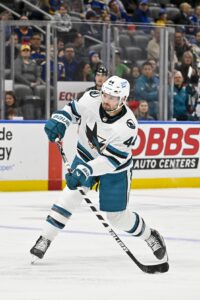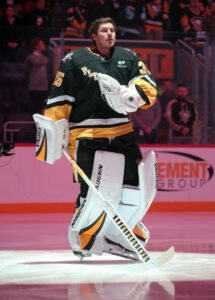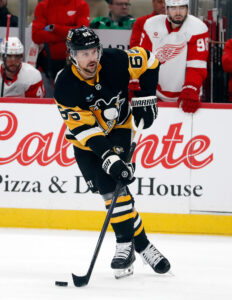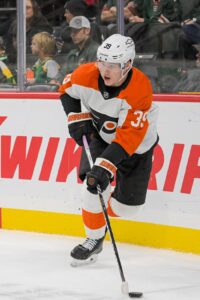There was a time, a decade ago, when former San Jose Sharks defenseman Marc-Édouard Vlasic was considered the most reliable and underpaid player in the NHL. Vlasic was earning $4.25MM in each year at the end of his five-year contract with the Sharks and had significantly outperformed his salary throughout his career.
That was until he signed a massive eight-year, $56MM contract in the summer of 2017, which completely altered the perception of the respected stay-at-home defender. The 38-year-old was bought out earlier this summer and hasn’t been much talked about in free agency, which isn’t surprising given his age and limited success in recent years. Vlasic has been playing below replacement level lately and struggled to stay in the lineup last year, being a healthy scratch at times and dealing with some injuries. All of this raises the question: what’s next for Vlasic?
Vlasic has publicly stated that he plans to play in the NHL this season, which is the goal of any professional hockey player. However, for him, that aspiration might not be realized given that he hasn’t been a consistent contributor since the 2017-18 season. Unfortunately, for both Vlasic and especially for the Sharks, his $7MM cap hit began during the 2018-19 season, coinciding with his decline. Vlasic’s performance significantly dropped from 2018 to 2020 and never recovered afterward. In fact, his poor play negatively affected star defensemen Brent Burns and Erik Karlsson, who both saw their numbers decline considerably when paired with Vlasic.
Vlasic’s salary, combined with his decline, played a significant role in the Sharks’ window of contention closing, as the flat salary cap worsened their cap struggles, along with Vlasic carrying arguably the worst contract in the league. Remarkably, Vlasic earned his contract extension after being one of, if not the top, defensive contributors in the NHL, while being vastly underpaid. However, for the Sharks, they signed the contract extension with Vlasic at precisely the wrong time.
So why does all of that matter if Vlasic no longer earns a big salary and can be signed for league minimum? Firstly, there are better defensive options still available in free agency who could have a more positive impact than Vlasic. Calvin de Haan could be signed cheaply, and he is four years younger and much more productive. Matt Grzelcyk is another player with a different style of game who posted 40 points last year. There are plenty of better options still available who haven’t signed with a team yet, including T.J. Brodie, and Ryan Suter. Even Brendan Smith and Oliver Kylington are better options at this point than Vlasic, and they’ve had to accept PTOs.
The second reason it matters is that if you are a contender, you wouldn’t be signing a player like Vlasic, with his current ability, to play NHL minutes for your team. Even as a seventh defenseman, you have more talented players available at this stage. On the other hand, if you are a rebuilding team like the Pittsburgh Penguins, you have young, gifted players you want to get ice time for and can’t afford to bring in a veteran who is no longer effective. The Penguins are an interesting case because they arguably have the worst defensive core in the NHL, and some might say that if they signed Vlasic, he would be their 15th-best option. That shows how far Vlasic’s game has declined over the past seven years; he could barely make the AHL on a team that is $13MM under the salary cap and has a weak defensive unit.
Vlasic’s chances of signing an NHL deal are slim, but it’s not impossible. NHL general managers often like to give a shot to an aging veteran who has had a solid career, and that would describe Vlasic perfectly. Older defensemen received multi-year contracts worth over $4MM this summer, so an NHL deal for Vlasic would be surprising but not entirely out of the question. The more probable scenario is that Vlasic gets an opportunity to demonstrate what he still has in the tank through a PTO. This would provide him with some practice time and potentially a chance to showcase himself in a few exhibition games, with the hope of securing an NHL contract or at least a two-way deal. It’s uncertain whether Vlasic would want that at this stage of his career, as some NHL players prefer not to ride the AHL buses anymore after a long NHL career, given family commitments. But only Vlasic knows what he truly desires.
Apart from a PTO or a two-way deal, there are plenty of options to find a job. He could explore the KHL, SHL, or other European leagues that might offer the chance to play every game. Still, family matters and lifestyle preferences will influence whether Vlasic chooses to take his game overseas. It’s rare to see a North American-born player who has earned the kind of money Vlasic has, make the move overseas after the age of 35, but it’s not unheard of.
Finally, there’s the final consideration: retiring and starting his post-hockey career, which is always challenging for any player, especially those who feel they have more to give. Vlasic may believe he can still contribute at the NHL level and might get a chance to prove it if he signs a PTO. However, at this stage, it could be the end of the line for a player who was once arguably the best stay-at-home defenseman in the league. Vlasic should have financial stability in his post-playing career, but he could no doubt find other ways to build a career in the game, thanks to his leadership experience and hockey IQ.
Photo by Jeff Curry-USA TODAY Sports








